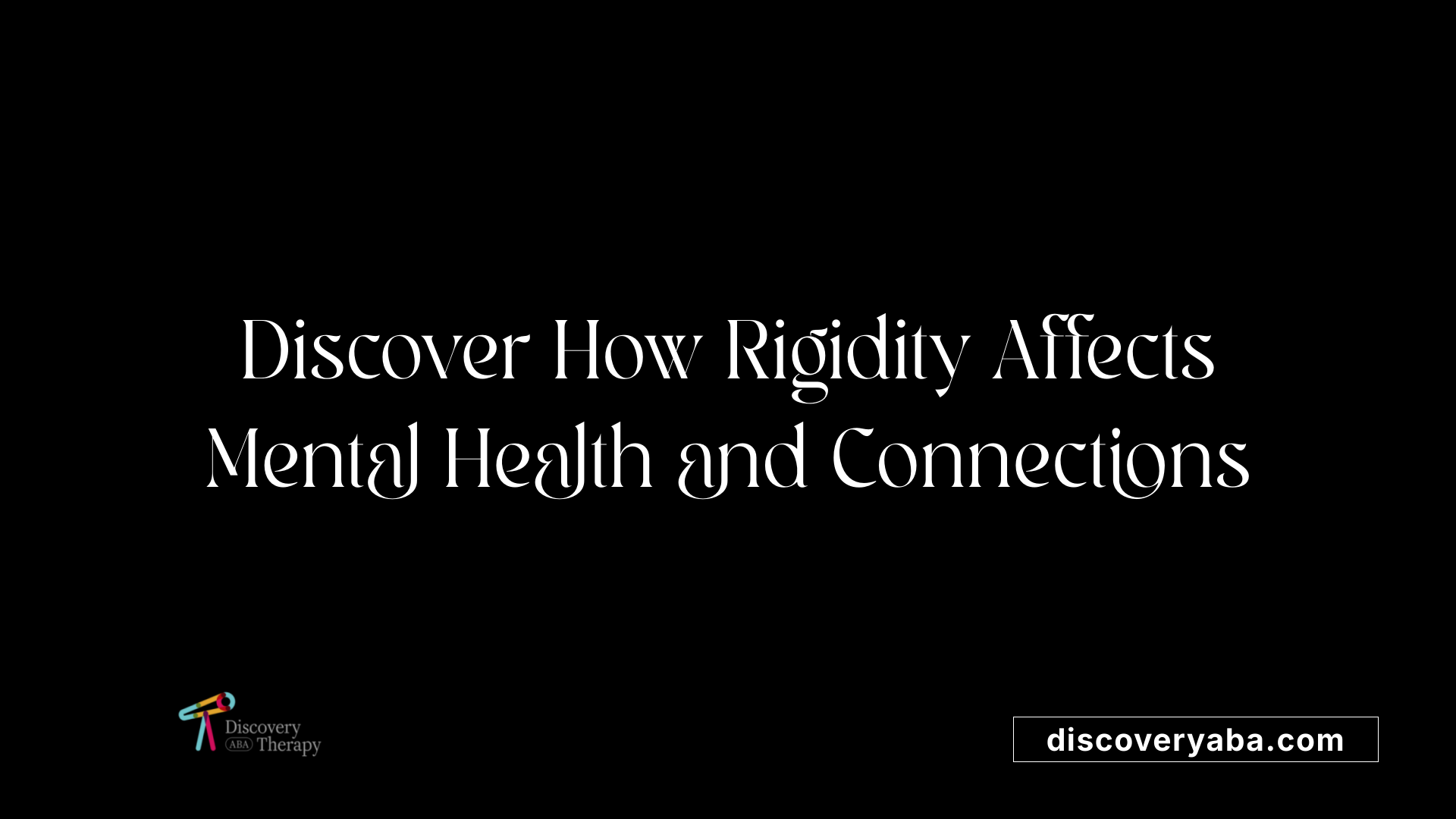How to identify overly rigid behaviors
Recognizing and Addressing Rigid Behaviors for Better Mental Flexibility

Understanding Overly Rigid Behaviors
Rigid behaviors and thought patterns can significantly impact mental health and personal relationships. Recognizing these inflexibilities early allows for targeted strategies to foster adaptability, emotional resilience, and healthier interactions. This article explores how to identify overly rigid behaviors, their underlying causes, and practical ways to promote mental flexibility across various contexts, including autism spectrum disorder and childhood development.
What Are Overly Rigid Behaviors and How Do They Manifest?

Signs and characteristics of rigid behaviors
Rigid behaviors are marked by inflexibility, resistance to change, and a persistent preference for sameness. Individuals displaying these behaviors often struggle to accept new ideas or adapt to unexpected circumstances. They tend to rely heavily on routines and may react negatively or with distress when routines are interrupted.
Physiologically, neuroimaging studies have shown overactivity in the anterior cingulate gyrus, a brain area linked to error detection and conflict monitoring, indicating cognitive inflexibility. People with autism spectrum disorder (ASD), for instance, commonly exhibit fixed interests, insistence on routines, and inflexible behaviors—traits that can be assessed through specialized evaluations.
Psychologically, these individuals often display black-and-white thinking, literal interpretation of information, and intolerance for uncertainty. Recognizing such signs is crucial for developing interventions aimed at enhancing flexibility and adaptive coping mechanisms.
Common examples of rigidity
Examples of rigid behaviors include:
- Following strict routines or schedules without variation.
- Resistance to change and difficulty adjusting to new situations.
- Repeating the same activities regardless of their usefulness.
- Difficulty transitioning from one task to another.
- Refusing to try new foods, activities, or explore new environments.
- Insisting on doing things a particular way and showing resistance to different approaches.
- Having inflexible thoughts like "things must be a certain way" or taking things literally.
In social contexts, such rigidity can manifest as misinterpretation of social cues, inability to see others' perspectives, and strong attachment to specific beliefs or interests. While commonly observed in autism, these behaviors can occur in various other settings where cognitive flexibility is compromised.
Differences between rigid boundaries and healthy boundaries
Boundaries are essential for establishing trust, safety, and mutual respect in relationships. Rigid boundaries are characterized by strict, inflexible limits that do not easily bend based on context or needs. These boundaries often serve as a defense mechanism against perceived threats or past trauma, but they can hinder genuine connection.
Healthy boundaries, by contrast, are adaptable and considerate. They allow individuals to protect their emotional space while remaining open to others. Healthy boundaries promote respectful dialogue, understanding, and trust, fostering stronger relationships.
Rigid boundaries tend to keep others at a distance, creating barriers that prevent intimacy and mutual vulnerability. They might involve denying oneself needs or refusing to compromise, often stemming from fears of betrayal, rejection, or past hurts.
In summary, while boundaries should protect and preserve personal integrity, inflexibility can lead to isolation and disconnect, emphasizing the importance of balancing boundaries with openness and flexibility.
Underlying Causes and Theoretical Models of Rigidity

What are the main models explaining the nature of fixed forms of behavior?
Various frameworks have been developed to understand why fixed patterns of behavior, or rigidity, occur. These models include neurodynamic, energy-economic, phylogenetic, person-environment relationship, dispositional, stressogenic, pathogenic, psychodynamic, behavioral-cognitive, and system models.
The neurodynamic model suggests that rigidity stems from inertness within nervous processes, meaning neural activity becomes sluggish or less adaptable. The energy-economic perspective attributes rigidity to habits formed around conserving energy — humans tend to stick with familiar routines to avoid expending additional effort. The phylogenetic model views FFB as behaviors conserved through evolution, similar to instinctive actions seen in animals.
Meanwhile, the person-environment relationship framework sees rigid behavior as a breakdown in harmony between one's internal organization and external influences, often causing difficulties in adjusting to change. The pathogenic model connects severity of rigidity with physiological and psychiatric conditions, indicating that extreme rigidity might signal underlying health issues.
The psychodynamic approach interprets rigidity, especially in neurosis, as a defense mechanism—protecting the individual from internal conflicts. The behavioral-cognitive model attributes fixed behaviors to faulty learning processes, such as reinforcement of inflexible responses. Lastly, the system model describes rigidity as a consequence of systemic over-rigidity, which can lead to hyperstability or collapse, depending on the context.
Are rigid behaviors indicative of underlying conditions like autism or ADHD?
Rigidity is notably present in autism spectrum disorder (ASD), manifesting through behaviors characterized by insistence on sameness, inflexible routines, and difficulty with change. These behaviors are often linked to restrictive interests and ritualized actions, reflecting deficits in cognitive flexibility. Similarly, ADHD can involve inflexibility in thinking and behavior, driven by impairments in executive functioning.
Both ASD and ADHD illustrate how neurological factors influence rigidity. In autism, low vagal tone and heightened emotional responses to specific interests further reinforce inflexible patterns. In ADHD, challenges with adaptive thinking stem from unique neurological pathways affecting flexibility. Recognizing these behaviors as neurodivergent traits helps tailor interventions aimed at increasing adaptability.
What is the connection between childhood experiences, trauma, and rigidity?
Childhood development plays a crucial role in shaping behavioral patterns seen in rigidity. Traumatic experiences such as abandonment, neglect, or abuse often produce deep-seated insecurities and distrust. These wounds lead children to develop rigid behaviors as a form of coping—establishing predictable routines or controlling environments to avoid vulnerability.
Such defensive strategies aim to create a sense of safety and mastery amid insecurity. Over time, these patterns may become ingrained, limiting emotional flexibility and adaptability into adulthood. Addressing these roots through trauma-informed therapies can be vital in fostering healing and building healthier, more adaptable behaviors.
How do neurobiological factors contribute to rigidity?
Neurobiologically, rigidity has been linked to specific brain activity patterns. For example, increased activity in the anterior cingulate gyrus (ACG) correlates with rigid thinking. Neurotransmitter imbalances, such as altered serotonin or dopamine levels, can also influence behavioral flexibility.
Moreover, deficits in neural circuits responsible for executive functions—like decision-making, impulse control, and flexible thinking—underpin many rigid behaviors. These biological factors interact with psychological and environmental influences, creating complex networks that sustain rigidity. Understanding their roles provides insight into targeted treatments, including neurofeedback, medication, and cognitive strategies.
| Model Type | Explanation | Impact on Rigidity |
|---|---|---|
| Neurodynamic | Inertness in nervous processes | Leads to sluggish adaptability |
| Energy-economic | Habit formation based on conserving energy | Reinforces routines and inflexibility |
| Phylogenetic | Fixed behaviors through evolution | Innate tendencies towards rigidity |
| Person-environment | Breakdown in internal-external harmony | Results in resistance to change |
| Pathogenic | Physiological and psychiatric links | Severity correlates with health issues |
| Psychodynamic | Defense mechanisms | Protect against internal conflicts |
| Behavioral-cognitive | Faulty learning | Reinforces inflexible responses |
| System | System rigidity | Causes hyperstability or collapse |
Understanding these models and their interactions allows for comprehensive approaches to assessing and addressing rigidity, emphasizing that behaviors are often multifaceted and rooted in complex biological, psychological, and social factors.
Impact of Rigid Behaviors on Well-being and Relationships

How can rigid thinking be identified in individuals?
Rigid thinking manifests in visible behaviors like perseveration, perfectionism, and compulsions. Individuals often get stuck in fixed routines or beliefs, exhibit all-or-nothing thinking, and have difficulty updating their views in response to new information. They may react defensively to criticism or change, cling stubbornly to habits, or reject alternative perspectives. Overactivity in brain regions like the anterior cingulate gyrus (ACG) is associated with such inflexible cognitive patterns. Recognizing these signs, especially in situations involving conflict, stress, or unfamiliar circumstances, can help in identifying rigid thought processes.
To observe rigid behaviors, pay attention to how routines, rules, and beliefs are maintained over time. Asking close others for feedback about moments when they notice inflexibility can also be revealing. Common indicators include black-and-white judgments, difficulty accepting different opinions, and resistance to change.
How can rigid behaviors impact mental health and relationships?
Rigid behaviors and thought patterns can profoundly affect emotional well-being. Such inflexibility often heightens stress, frustration, and helplessness, creating a cycle that may lead to or worsen conditions like depression and anxiety. For example, an intense need for control or perfectionism raises the level of internal pressure and dissatisfaction.
In relationships, rigidity hampers effective communication. When individuals refuse to consider their partner’s viewpoints or cling to rigid boundaries, misunderstandings are more likely to occur. This can foster emotional disconnection, conflict, and even the breakdown of trust. For instance, controlling behaviors or avoidance of difficult topics signal underlying rigidity driven by anxiety or insecurity.
Furthermore, rigid thinking reduces problem-solving flexibility, making it hard to find solutions during crises. It also escalates emotional responses such as anger or fear, impairing the capacity for compromise and empathy. Over time, these patterns can lead to social isolation, as others may find it challenging to engage with inflexible individuals.
Promoting psychological flexibility through mindfulness practices, cognitive-behavioral strategies, and therapies like Rational Emotive Behavior Therapy (REBT) helps reduce these negative impacts. By challenging rigid beliefs and embracing alternative viewpoints, individuals can improve mental health and foster more harmonized relationships.
Implications for problem-solving and conflict management
Rigid thinking limits the ability to see multiple solutions, often resulting in a narrow focus on one course of action. This can exacerbate conflicts and prolong resolution times.
During disagreements, inflexible individuals may dismiss alternative solutions or refuse to compromise, escalating tension. This rigidity hampers open dialogue and understanding. It can also lead to defensive reactions, further fueling disputes.
Effective conflict management involves practicing flexible thinking—considering multiple perspectives, evaluating options openly, and remaining open to change.
Learning to tolerate uncertainty and accepting that mistakes are part of growth are crucial steps toward better problem-solving capabilities. Techniques such as reframing setbacks as learning opportunities and practicing mindfulness can make it easier to adapt during crises.
Risks of social isolation and misunderstanding
When rigidity dominates behavior, individuals often struggle with social interactions. They may set rigid boundaries, react defensively, or dismiss others' opinions, which can create misunderstandings.
Overly rigid boundaries, often rooted in past trauma or insecurity, can lead to social withdrawal to avoid potential hurt. Such boundaries may manifest as an inability to trust or share feelings and as a tendency to cut people off at the slightest disagreement.
This pattern reduces opportunities for meaningful connections and fosters misjudgments about others’ intentions. Over time, rigid individuals may become isolated, experiencing loneliness and increased emotional distress.
Understanding these risks emphasizes the importance of cultivating flexibility—learning to relax rules, accept differences, and adapt behaviors—to foster healthier social interactions.
| Aspect | Effects | Strategies to Improve |
|---|---|---|
| Mental health consequences | Increased anxiety, depression, perseveration | Practice mindfulness, therapy (REBT, CBT), challenge rigid beliefs |
| Relationship strain | Poor communication, conflict, emotional disconnection | Increase empathy, promote open dialogue, set flexible boundaries |
| Problem-solving | Reduced adaptability, unresolved crises | Reframe setbacks, consider multiple solutions, develop tolerance for uncertainty |
| Social understanding | Misinterpretations, social withdrawal | Gradually relax boundaries, engage in flexible social interactions, seek support |
Understanding and addressing rigid behaviors is vital for nurturing mental resilience and improving interpersonal relations. Building psychological flexibility allows individuals not only to cope better with life's challenges but also to deepen their connections with others, creating a more fulfilling and balanced life environment.
Strategies for Increasing Flexibility and Managing Rigidity
What strategies can help reduce rigidity and promote mental flexibility?
Promoting mental flexibility involves adopting several practical strategies. One of the foundational methods is mindfulness and acceptance techniques. These practices help individuals become more aware of their thoughts and feelings without immediately reacting to them. Mindfulness encourages observing rigid patterns as they arise, creating space for thoughtful responses rather than automatic reactions.
Challenging rigid thoughts and beliefs is another essential approach. By exploring multiple perspectives and questioning absolute statements like "I must" or "I should," people can begin to see alternatives and soften their rigid mindset.
Introducing unpredictability through role-plays, varied routines, and new experiences helps the brain adapt to change more easily. Regularly seeking new challenges, learning new skills, or exploring different cultures broadens cognitive flexibility and diminishes the reliance on familiar, inflexible patterns.
Creating supportive routines and environments also contributes to flexibility. Clear routines with built-in room for spontaneity enable individuals to feel secure while also practicing adaptability. Using planning tools such as calendars or visual schedules can make transitions smoother, reducing anxiety associated with change.
Modern psychological therapies like Cognitive-Behavioral Therapy (CBT), Dialectical Behavior Therapy (DBT), and Acceptance and Commitment Therapy (ACT) incorporate techniques that foster flexible thinking. These include acceptance strategies, defusion of negative thoughts, and values-based living.
In addition to adult interventions, teaching and modeling flexibility in children is crucial. Children benefit from understanding that change is a natural part of life and that mistakes are opportunities for learning. Using stories, play, and social stories to demonstrate adaptability helps develop these skills early.
Overall, cultivating a mindset of curiosity and resilience, combined with consistent practice of flexible behaviors, can progressively reduce rigidity and enhance mental adaptability.
Fostering Balance Between Rigidity and Flexibility
While rigidity can serve as a coping mechanism in uncertain or threatening environments, excessive inflexibility hampers personal growth, mental health, and social relationships. Recognizing overly rigid behaviors involves observing specific actions such as strict routines, black-and-white thinking, and resistance to change. Underlying causes range from neurobiological factors and developmental experiences to trauma and personality traits. Addressing rigidity involves implementing strategies like mindfulness, challenging rigid beliefs, and gradually exposing oneself to new experiences. For children and individuals with neurodivergent conditions like autism, tailored supportive approaches help foster adaptability. Ultimately, cultivating mental flexibility enriches life quality by promoting resilience, healthier connections, and a broader understanding of diverse perspectives.
References
- Fixed Forms of Behavior as Excessively Rigid Behavior in Normal ...
- 10 Ways to Reduce Rigidness, Decrease Anxiety, Increase ...
- Are You Too Routinized and Rigid? Maybe You're Anxious
- Controlling, Rigid, Argumentative Behavior (What It Means and What ...
- Rigidity (psychology) - Wikipedia
- Options for responding well to an overly-rigid person - Peter K. Gerlach
- Rigid Thinking and Rational Living Don't Work Well Together
- The Rigidity-Entropy Complex - Psychology Today
Does Your Child Have An Autism Diagnosis?
Learn More About How ABA Therapy Can Help
Find More Articles
Contact us
North Carolina, Nevada, Utah, Virginia
New Hampshire, Maine
Arizona, Colorado, Georgia, New Mexico, Oklahoma, Texas
.avif)




































































































